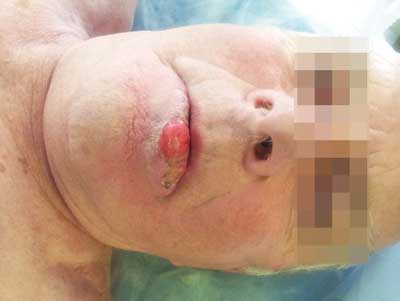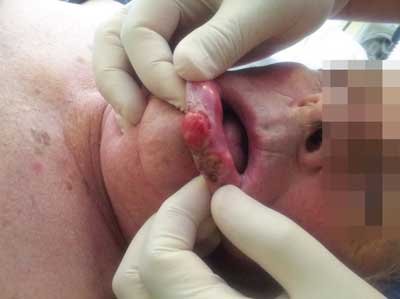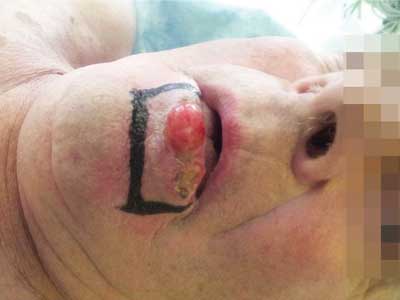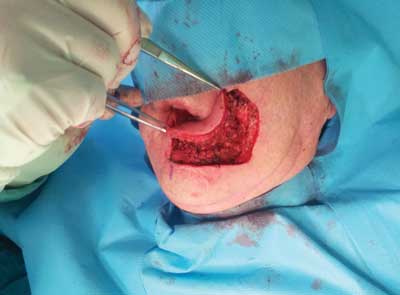*Konrad Wroński1, Zbigniew Masłowski2, Leszek Frąckowiak3, Janusz Kaczor2
Gillies fan flap for lower lip reconstruction – case report
1Department of Surgical Oncology, Faculty of Medicine, University of Warmia and Mazury in Olsztyn, Poland
Head of Department: Monika Rucińska, MD, PhD
2Department of Surgical Oncology, Hospital Ministry of Internal Affairs with Warmia and Mazury Oncology Centre, Olsztyn, Poland
Head of Department: Andrzej Lachowski, MD
3Department of Public Health and Epidemiology, Faculty of Medicine, University of Warmia and Mazury in Olsztyn, Poland
Head of Department: prof. Anna Abramczyk, MD, PhD
Summary
Lips have important aesthetic and functional roles in the human body. First lip reconstruction was performed in 25 AD by a Roman surgeon who made relaxing incisions in the cheek to close defect of the lower lip. Modern surgical technics of lip reconstruction were developed in the mid-1800s, and basics principles have not changed significantly since then.
Lower lip malignant neoplasms should be treated aggressively and effect reconstruction depend on few things. Proper planning, fine instruments, proper suture material and experience of surgeons team are the most important factors in reconstructive treatment. In the case of lip cancer, where the surgeon provides excision more than 2/3 of the lip, it can use several different techniques to reconstruct the lips. One of these techniques is Gillies fan flap.
In the following article the authors presented a case of a 74-year-old man, Caucasian race, who was admitted to the hospital because of diagnosed lower lip carcinoma. The patient underwent surgery – wild excision of carcinoma and Gillies fan flap reconstruction. The patient was satisfied with reconstruction lower lip and aesthetic and functional effect of treatment was assessed by surgeons and patient as fully satisfying.
INTRODUCTION
Lips have important aesthetic and functional roles in the human body. First lip reconstruction was performed in 25 AD by a Roman surgeon who made relaxing incisions in the cheek to close defect of the lower lip (1). Modern surgical technics of lip reconstruction were developed in the mid-1800s, and basics principles have not changed significantly since then (2, 3).
According to the National Cancer Registry, in Poland lips carcinomas are rare tumors, in men observed in 0.5% of cases and in women population in 0.1% of cases. The incidence of lip carcinoma in 2010 amounted to 420, of whom 318 in men and 92 in women. In Poland the incidence in men is about 5 times higher than in women. Most cancers lip occurs in the seventh-eighth decade of life and the risk of this cancer increases with age in both sexes. The number of deaths from lip carcinoma reported in 2010 to the National Cancer Registry in Poland was 105, of which 81 in men and 24 in women. Deaths in men were approximately 10 times more often than women. Most deaths from lip cancer occurs in the eighth decade of life and the risk of death due to this carcinoma increases with age in both sexes.
CASE REPORT
A 74-year-old man, Caucasian race, was admitted to the Department of Surgical Oncology because of diagnosed lower lip carcinoma (fig. 1, 2). In an interview with the patient, he informed us that tumor was present for 12 months and gradually expanded. The patient reported no pain in this area. Surgical biopsy before treatment showed squamous cell carcinoma.

Fig. 1. Lower lip carcinoma

Fig. 2. Squamous cell carcinoma of the lower lip
He had no any other symptoms, there was no history of weight loss and loss of appetite. The patient was not treated for chronically diseases. Blood test and other routine hematological examinations and biochemical tests were within normal limits.
On physical examination, 3 cm of lower lip was infiltrated by carcinoma (fig. 1-3). There were not enlarged local lymph nodes. Also ultrasound examination of the neck lymph nodes did not show pathologically enlarged lymph nodes. Clinical lower lip carcinoma was – cT2N0M0.

Fig. 3. Cancer of the lower lip – marked marker excision margins
The patient was qualified for surgery. There was cut off tumor of the lower lip and the patient underwent Gillies fan flap reconstruction for freshly created lower lip defect (fig. 3-5). The duration of surgery was 90 minutes. Pathological examination showed squamous cell carcinoma G2. Patient after surgery felt good and did not complain of pain. The postoperative period was uncomplicated and the patient left the ward in the fourth day after operation. The patient is under control of outpatient surgical oncology. There was no observed recurrence of neoplasm disease for 6 months.

Fig. 4. Status after resection of the lower lip carcinoma during reconstruction the defect in the lower lip
DISCUSSION
Lip carcinoma is rare neoplasm responsible for the development of UV radiation, smoking, alcohol abuse, chronic herpes simplex virus infection and chronic diseases associated with immunosuppression (2, 3). The most frequent histopathological type of malignant lip neoplasm is squamous cell carcinoma. Cancer angle of the mouth and upper lip cancer have worse prognosis than cancer of the lower lip at a similar stage.
The diagnosis of the lip carcinoma is a surgical biopsy. In the case of confirmation of lip cancer, each patient should undergo pantomogram or jaw CT, ultrasound of the neck lymph nodes with a possible biopsy of suspected metastatic lymph nodes. The stage of the cancer process is evaluated based on the TNM classification (tab. 1). TNM staging system allows you to take effective decisions about the treatment of the patient.
Table 1. TNM classification of carcinomas of the oral cavity (UICC/AJCC TNM 7 from 2009 year)
| T – Primary tumour |
| TX | Primary tumour cannot be assessed |
| T0 | No evidence of primary tumour |
| Tis | Carcinoma in situ |
| T1 | Tumour 2 cm or less in greatest dimension |
| T2 | Tumour more than 2 cm but not more than 4 cm in greatest dimension |
| T3 | Tumour more than 4 cm in greatest dimension |
| T4a (lip) | Tumour invades through cortical bone, inferior alveolar nerve, floor of mouth, or skin (chin or nose) |
| T4a (oral cavity) | Tumour invades through cortical bone, into deep/extrinsic muscle of tongue (genioglossus, hyoglossus, palatoglossus, and styloglossus), maxillary sinus, or skin of face |
| T4b (lip and oral cavity) | Tumour invades masticator space, pterygoid plates, or skull base; or encases internal carotid artery |
| Note: Superficial erosion alone of bone/tooth socket by gingival primary is not sufficient to classify a tumour as T4. |
| N – Regional lymph nodes |
| NX | Regional lymph nodes cannot be assessed |
| N0 | No regional lymph node metastasis |
| N1 | Metastasis in a single ipsilateral lymph node, 3 cm or less in greatest dimension |
| N2 | Metastasis as specified in N2a, 2b, 2c below |
| N2a | Metastasis in a single ipsilateral lymph node, more than 3 cm but not more than 6 cm in greatest dimension |
| N2b | Metastasis in multiple ipsilateral lymph nodes, none more than 6 cm in greatest dimension |
| N2c | Metastasis in bilateral or contralateral lymph nodes, none more than 6 cm in greatest dimension |
| N3 | Metastasis in a lymph node more than 6 cm in greatest dimension |
| Note: Midline nodes are considered ipsilateral nodes. |
| M – Distant metastasis |
| MX | Distant metastasis cannot be assessed |
| M0 | No distant metastasis |
| M1 | Distant metastasis |
| Stage grouping |
| Stage 0 | Tis | N0 | M0 |
| Stage I | T1 | N0 | M0 |
| Stage II | T2 | N0 | M0 |
| Stage III | T1, T2 | N1 | M0 |
| | T3 | N0, N1 | M0 |
| Stage IVA | T1, T2, T3 | N2 | M0 |
| | T4a | N0, N1, N2 | M0 |
| Stage IVB | Any T | N3 | M0 |
| | T4b | Any N | M0 |
| Stage IVC | Any T | Any N | M1 |
In the case described by the authors in this article, tumor stage T2N0M0 method of treatment is tumor resection with adequate margins of healthy tissue and adjacent tissue reconstruction. An alternative could be radiation therapy.
Lower lip malignant neoplasms should be treated aggressively and effect reconstruction depend on few things. Proper planning, fine instruments, proper suture material and experience of surgeons team are the most important factors in reconstructive treatment. In the case of lip cancer, where the surgeon provides excision more than 2/3 of the lip, it can use several different techniques to reconstruct the lips. One of these techniques is Gillies fan flap.
This article describes a case of a patient where a team of surgeons had to cut more than 2/3 of the lower lip cancer (fig. 3). Always in the case of squamous cell carcinoma is recommended margin of 3 to 10 mm, which was used in the described patient (4, 5). It was decided to execute the reconstruction of the lower lip means Gillies fan flap (fig. 5).

Fig. 5. The final effect after reconstruction of the lower lip defect Gillies fan flap
Gillies fan flap is a variation on the Estlander flap. This flap is substantially denervated. The problem is the reconstruction of vermilion, in the case described in the article patient was able to reproduce the red lip. It is believed that Gillies fan flap may be used to reconstruction full-length of the lower lip after surgical treatment. The patient was satisfied with reconstruction lower lip and aesthetic and functional effect of treatment was assessed by surgeons and patient as fully satisfying.
Patients suffer from lip carcinoma should be treated in high-specialized oncological centers where different therapies can be used for different stages of the lip carcinoma. In the case of the patient as described by the authors selected the most optimal course of treatment, and the final result was satisfactory not only for the surgeon but also for the patient. Patients should be operated by the experienced reconstructive surgeons. Oncological surgeon performing the procedure lip reconstruction after resection of cancer should know the different techniques and have experience in performing this type of surgery.
Piśmiennictwo
1. Mazzola RF, Lupo G: Evolving concepts in lip reconstruction. Clin Plast Surg 1994; 11: 583-617. 2. Webster RC, Coffey RJ, Kelleher RE: Total and partial reconstruction of the lower lip with innervated muscle-bearing flaps. Plast Reconstr Surg 1960; 25: 360-371. 3. Goldstein MH: The elastic flap for lip repair. Plast Reconstr Surg 1990; 85: 446-452. 4. Sadove RC, Luce EA, McGrath PC: Resection of the lower lip and chin with the composite radial forearmpalmaris longus free flap. Plast Reconstruct Surg 1991; 88: 209-214. 5. Kuttenberger JJ, Hardt N: Results of a modified staircase technique for reconstruction of the lower lip. J Craniomaxillofac Surg 1997; 25: 239-244.




